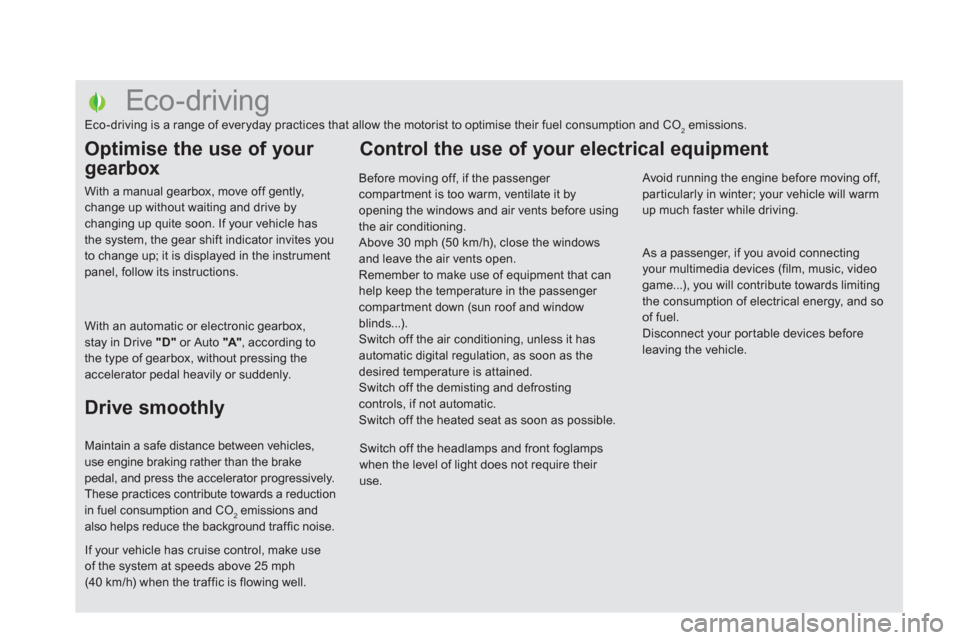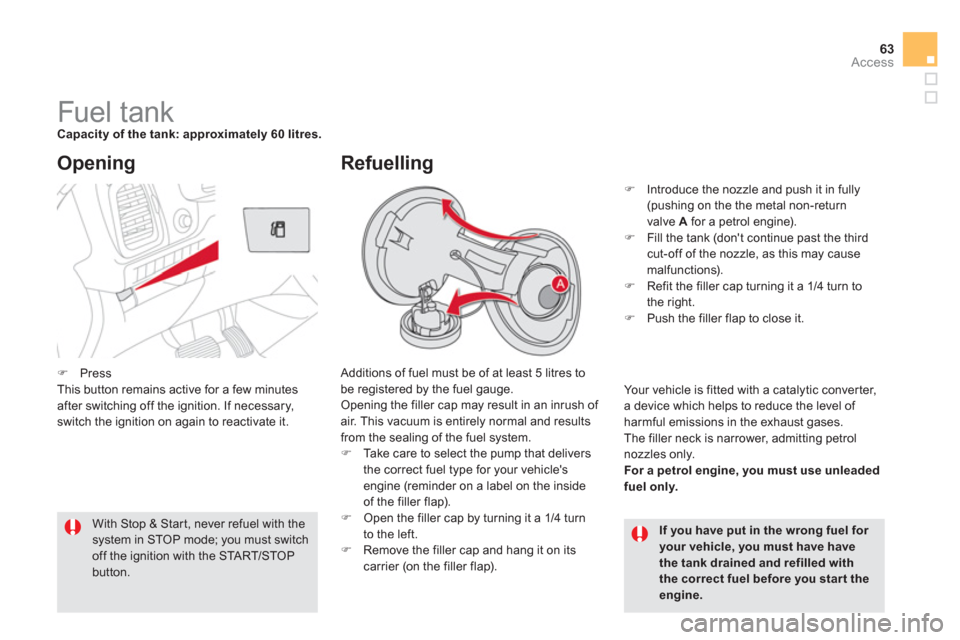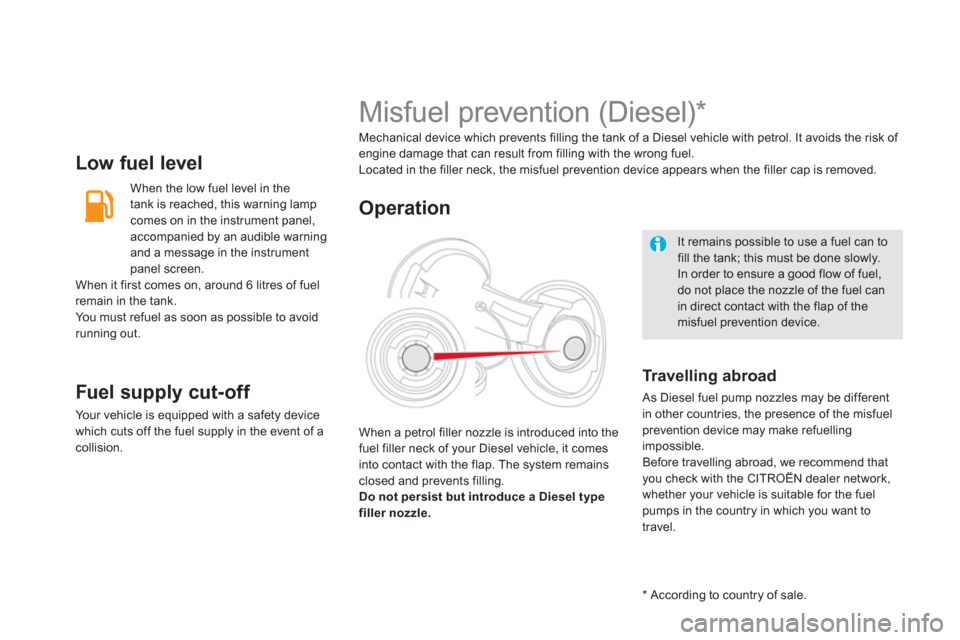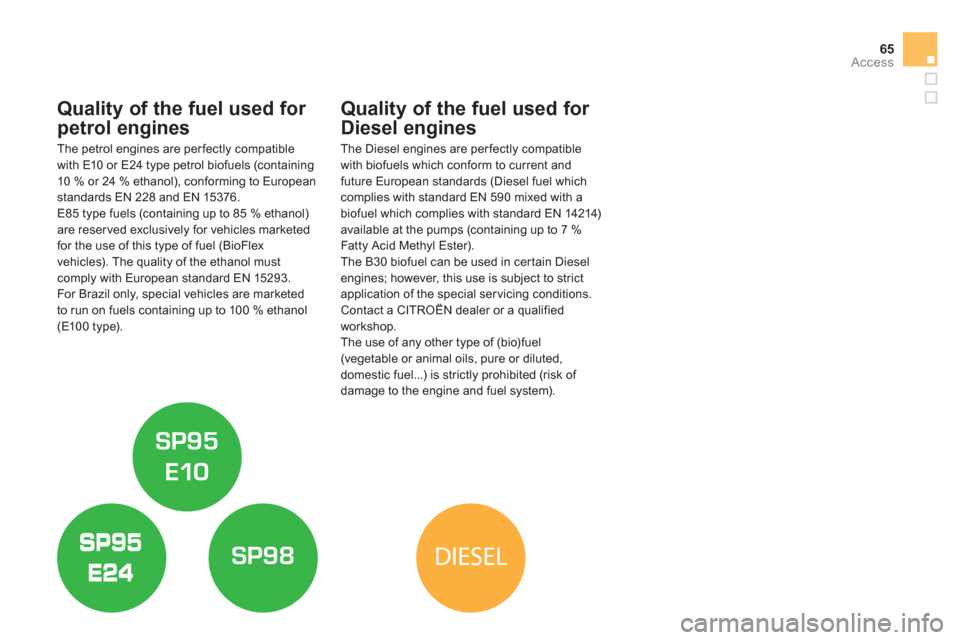fuel type Citroen DS5 2011 1.G Owner's Manual
[x] Cancel search | Manufacturer: CITROEN, Model Year: 2011, Model line: DS5, Model: Citroen DS5 2011 1.GPages: 348, PDF Size: 10.33 MB
Page 26 of 348

Eco-driving
Eco-driving is a range of everyday practices that allow the motorist to optimise their fuel consumption and CO2emissions.
Optimise the use of your
gearbox
With a manual gearbox, move off gently,change up without waiting and drive by changing up quite soon. If your vehicle has the system, the gear shift indicator invites youto change up; it is displayed in the instrumentpanel, follow its instructions.
With an automatic or electronic gearbox, stay in Drive "D"or Auto "A"
, according to the type of gearbox, without pressing theaccelerator pedal heavily or suddenly.
Drive smoothly
Maintain a safe distance between vehicles,use engine braking rather than the brake pedal, and press the accelerator progressively. These practices contribute towards a reductionin fuel consumption and CO2emissions andalso helps reduce the background traffic noise.
If your vehicle has cruise control, make useof the system at speeds above 25 mph(40 km/h) when the traffic is flowing well.
Control the use of your electrical equipment
Before moving off, if the passenger compartment is too warm, ventilate it byopening the windows and air vents before using the air conditioning.
Above 30 mph (50 km/h), close the windows and leave the air vents open.
Remember to make use of equipment that canhelp keep the temperature in the passenger compartment down (sun roof and windowblinds...). Switch off the air conditioning, unless it has automatic digital regulation, as soon as thedesired temperature is attained.
Switch off the demisting and defrostingcontrols, if not automatic.
Switch off the heated seat as soon as possible.
Switch off the headlamps and front foglamps when the level of light does not require their use.
Avoid running the engine before moving off,particularly in winter; your vehicle will warmup much faster while driving.
As a passenger, if you avoid connecting your multimedia devices (film, music, videogame...), you will contribute towards limitingthe consumption of electrical energy, and soof fuel.
Disconnect your por table devices beforeleaving the vehicle.
Page 65 of 348

63Access
Fuel tank Capacity of the tank: approximately 60 litres.
Additions of fuel must be of at least 5 litres to
be registered by the fuel gauge.Opening the filler cap may result in an inrush of air. This vacuum is entirely normal and results from the sealing of the fuel system.�) Take care to select the pump that delivers
the correct fuel type for your vehicle'sengine (reminder on a label on the inside
of the filler flap).�) Open the filler cap by turning it a 1/4 turn
to the left. �) Remove the filler cap and hang it on its carrier (on the filler flap).
Opening
If you have put in the wrong fuel for your vehicle, you must have havethe tank drained and refilled with the correct fuel before you start theengine.
With Stop & Star t, never refuel with the system in STOP mode; you must switchoff the ignition with the START/STOP button.
Refuelling
�)
Introduce the nozzle and push it in fully(pushing on the the metal non-return
valve Afor a petrol engine). �) Fill the tank (don't continue past the thirdcut-off of the nozzle, as this may cause malfunctions). �)
Refit the filler cap turning it a 1/4 turn to
the right. �) Push the filler flap to close it.
Your vehicle is
fitted with a catalytic converter,
a device which helps to reduce the level of
harmful emissions in the exhaust gases.
The filler neck is narrower, admitting petrol
nozzles only.
For a petrol engine, you must use unleaded fuel only.
�)Press
This button remains active for a few minutesafter switching off the ignition. If necessary, switch the ignition on again to reactivate it.
Page 66 of 348

Low fuel level
When the low fuel level in the
tank is reached, this warning lamp comes on in the instrument panel,
accompanied b
y an audible warning
and a message in the instrument
panel screen.
When it first comes on, around 6 litres of fuelremain in the tank.
You must refuel as soon as possible to avoid running out.
Fuel supply cut-off
Your vehicle is equipped with a safety device
which cuts o
ff the fuel supply in the event of a collision.
It remains possible to use a fuel can tofill the tank; this must be done slowly. In order to ensure a good flow of fuel, do not place the nozzle of the fuel canin direct contact with the flap of themisfuel prevention device.
Misfuel prevention (Diesel) *
Mechanical device which prevents filling the tank of a Diesel vehicle with petrol. It avoids the risk of engine damage that can result from filling with the wrong fuel.
Located in the filler neck, the misfuel prevention device appears when the filler cap is removed.
When a
petrol filler nozzle is introduced into the fuel filler neck of your Diesel vehicle, it comes
into contact with the flap. The system remains closed and prevents filling. Do not persist but introduce a Diesel type
filler nozzle.
Operation
Tr a v e l l i ng abroad
As Diesel fuel pump nozzles may be different
in other countries, the presence of the misfuel
prevention device may make refuellingimpossible.
Before travelling abroad, we recommend that you check with the CITROËN dealer network,
whether your vehicle is suitable for the fuelpumps in the country in which you want to
travel.
*
Accordin
g to country of sale.
Page 67 of 348

DIESEL
65
Access
Quality of the fuel used for
petrol engines
The petrol engines are perfectly compatible
with E10 or E24 type petrol biofuels (containing10 % or 24 % ethanol), conforming to Europeanstandards EN 228 and EN 15376.
E85 type fuels (containing up to 85 % ethanol)
are reser ved exclusively for vehicles marketed for the use of this type of fuel (BioFlex
vehicles). The quality of the ethanol mustcomply with European standard EN 15293.
For Brazil only, special vehicles are marketed
to run on fuels containing up to 100 % ethanol(E10 0 type).
Quality of the fuel used for
Diesel engines
The Diesel engines are per fectly compatiblewith biofuels which conform to current and
future European standards (Diesel fuel which complies with standard EN 590 mixed with a
biofuel which complies with standard EN 14214)available at the pumps (containing up to 7 % Fatty Acid Methyl Ester).
The B30 biofuel can be used in cer tain Diesel
engines; however, this use is subject to strictapplication of the special ser vicing conditions.
Contact a CITROËN dealer or a qualified
workshop.
The use of any other type of (bio)fuel (vegetable or animal oils, pure or diluted,
domestic fuel...) is strictly prohibited (risk of
damage to the engine and fuel system).